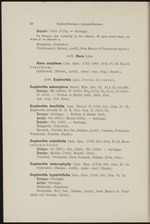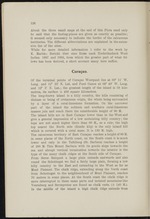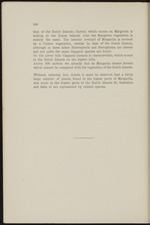| 1 |
 |
“...56
Euphorbiaceae—Anacardiaceae.
Bonaire: Grkz (7175). — Suringar.
On Curasao also occurring in the interior, 38 spots noted there; on
Aruba 2; on Bonaire 4.
Margarita. (Johnston).
Florida austr., Baham., Antill.,from Mexico to Venezuela.(Symb.).
4493. Hura Linn.
Hura crepitans Linn. Spec. (1753) 1008; Gris. FI. 50. Zand-
kokerboom.
Cultivated. [Baham., Antill., Amer. cont. trop.] (Symb.).
4498. Euphorbia Linn. Jeerba die leetsji.
Euphorbia adenoptera Bertoi. Misc. Bot. III. 20, t. 23, vel affin.
Curasao: Mt (4862a); St (5056); Wa3 (5103); H2 (5121); Jt (5424);
Jt (5425). — Britton & Shafer 2920,. 2950, 3141.
Am. trop. (Ind. Kew.).
Euphorbia buxifolia Lam. Encycl. II (1786) 421; Gris. FI. 53;
Euphorbia litoralis H. B. K. Nov. Gen. II (1817) 54.
Curasao: Suringar, — Britton & Shafer 2933.
Aruba: Ser (6511); Mansz (6554). — Suringar.
Bonaire: Okz (7237). — Suringar.
Margarita. (Johnston).
Bermud., Florida, Key Ins., Baham., Antill., Yucatan, Honduras,
Venezuela, Brasilia. (Symb.).
Euphorbia...”
|
|
| 2 |
 |
“...56
E uphoxbiaceae—Anacardiaceae.
Bonaire: Grkz (7175). — Suringar.
On Curasao also occurring in the interior, 33 spots noted there; on
Aruba 2; on Bonaire 4.
Margarita. (Johnston).
Floridaaustr., Baham., Antill.,from Mexico to Venezuela. (Symb.).
4493. Hura Linn.
Hura crepitans Linn. Spec. (1753) 1008; Gris. FI. 50. Zaind-
kokerboom.
Cultivated. [Baham., Antill., Araer. cont. trop.] (Symb.).
4498. Euphorbia Linn. Jeerba die leetsji.
Euphorbia adenoptera Bertol. Misc. Bot. III. 20, t. 23, vel affin.
Curasao: Mt (4862a); St (5056); Wa3 (5103); H2 (5121); Jt (5424);
Jt (5425). — Britton & Shafer 2920, 2950, 3141.
Am. trop. (Ind. Kew.).
Euphorbia buxifolla Lam. Encycl. II (1786) 421; Gris. FI. 53;
Euphorbia litoralis H. B. K. Nov. Gen. II (1817) 54.
Curasao: Suringar, — Britton & Shafer 2933.
Aruba: Ser (6511); Mansz (6554). — Suringar.
Bonaire: Okz (7237). — Suringar.
Margarita. (Johnston).
Bermud., Florida, Key Ins., Baham., Antill., Yucatan, Honduras,
Venezuela, Brasilia. (Symb.).
Euphorbia...”
|
|
| 3 |
 |
“...country; the
tops are not much higher there than 60 M., as a rule; the high
top nearer the North side (Ronde klip) is the only inland hill
which is covered with a coral mass. It is 130 M. high,
The calcareous territory of East Curagao reaches a height of 60 M.
in some places of the North coast, on the South coast it is much
lower and only in the Tafelberg (St. Barbara) reaches a height
of 200 M. This Mount Barbara with its gentle slope towards the
sea and abrupt vertical termination towards the interior is the
type of the many chalk ridges at the South side of Curagao.
From Seroe Seinpost a large plain extends eastwards and also
round the Schottegat we find a fairly large plain, forming a low
hilly country to the East and extending to the West as far as
Mont Plaisant. The chalk ridge, extending along the North coast
from Schottegat to the neighbourhood of Mont Plaisant, reaches
70 metres in some places. At the South coast the chalk ridge is
more interrupted in these same parts and isolated...”
|
|
| 4 |
 |
“...166
that of the Dutch Islands; Castela which occurs on Margarita is
lacking in the Dutch Islands. Also the Mangrove vegetation is
mainly the same. The interior lowland of Margarita is covered
by a Croton vegetation, similar to that of the Dutch Islands,
although in these latter Heteropteris and Sterophoma are absent
and not quite the same Capparis species are found.
On the lower hills Capparis linearis is characteristic, which occurs
in the Dutch Islands on the higher hills.
Above 300 metres we alraedy find on Margarita denser forests
which cannot be compared with the vegetation of the Dutch Islands.
Without entering into details it must be observed that a fairly
large number of plants, found in the higher parts of Margarita,
also occur in the higher parts of the Dutch Islands St. Eustatius
and Saba or are represented by related species....”
|
|
